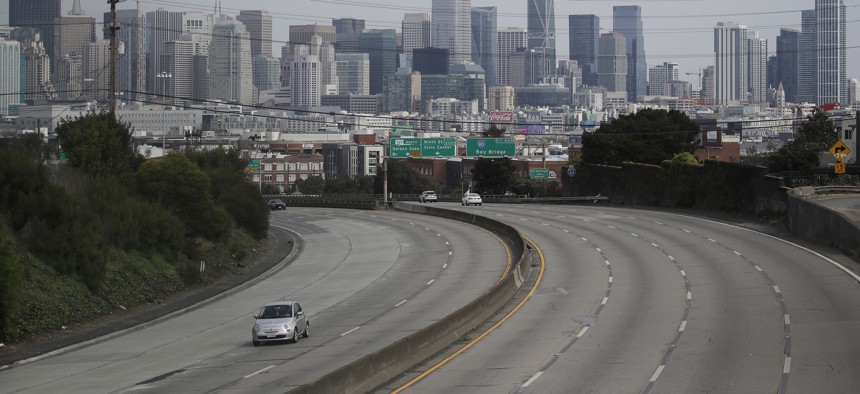Driving Actually Got Deadlier During the Pandemic

In this March 29, 2020 file photo, light traffic is seen on Highway 101 in San Francisco, amid coronavirus concerns. AP Photo/Jeff Chiu
The rate of motor-vehicle deaths per miles driven was up 23.5% in May compared to the same time last year, according to the National Safety Council.
Driving has become more dangerous even with fewer cars on the road during the coronavirus pandemic, according to a new report.
The number of miles that motorists drove in the first five months of 2020 decreased by about 17% compared to 2019, according to the National Safety Council. But fatal vehicle crashes have not decreased at the same pace, meaning that the drivers who do get on the road are now involved in fatal crashes at a higher rate.
“We are driving so much less yet we are not seeing a commensurate reduction in deaths,” said Lorraine Martin, president and CEO of the National Safety Council, during a news conference about the report. “It’s clear that our open roads have created somewhat of an open season for reckless driving.”
Motor vehicle deaths were down in the first five months of 2020, totaling 13,890 deaths compared to 14,780 deaths during the same period last year. But the rate of motor vehicle deaths per miles driven is on the rise, jumping 23.5% in May 2020 compared to May 2019, according to the report. It’s the third month in a row this year the fatality rate per miles driven has increased, the report found.
Put another way, there was one death for every 84 million miles driven in May 2019, but one death for every 68 million miles driven in May 2020, according to Ken Kolosh, the manager of statistics for the NSC.
Traffic safety experts cautioned that it’s too soon to say for certain why the risk of dying from a motor vehicle crash has grown for those motorists on the road. But based on anecdotal evidence, they believe speeding is a likely cause.
Traffic congestion diminished as businesses closed and workers stayed home to prevent the spread of the virus. Motorists who have been driving may have taken advantage of the wide-open roads to travel faster than the speed limit, said Jonathan Adkins, executive director of the Governors Highway Safety Association.
The Ohio State Highway Patrol reported issuing nearly double the amount of speeding tickets to drivers going faster than 100 miles per hour between March 24 and July 19 this year compared to the same time last year.
In New York City, the early epicenter of the pandemic, automated speed cameras issued 24,765 speeding tickets on March 27, up from the daily average of 12,672 tickets issued in February, The New York Times reported.
In some areas, police may have backed off speed enforcement campaigns to reduce officers face-to-face contact with the public during the pandemic, which could have emboldened some drivers, Adkins said.
Alcohol could also possibly be a factor for people who have turned to drinking to cope with pandemic-related stress, Kolosh said.
The National Highway Traffic Safety Administration rolled out a new safety-related ad campaign this summer in response to the anecdotal reports of increased speeding and reckless driving during the pandemic, a spokesman said.
Not all states have seen the same trends in fatal motor-vehicle crashes. The NSC report found six states recorded increases of 15 deaths or more in the first five months of the year—New Hampshire, Connecticut, Louisiana, Missouri, Arkansas, and North Carolina.
But in nine states—Tennessee, Wyoming, Mississippi, Maryland, Michigan, South Carolina, Pennsylvania, Arizona, and Florida—the number of deaths decreased by more than 30 in the first five months of the year.
To address the issue, state and local governments could step up automated traffic enforcement through the use of speed cameras, Adkins said.
As states begin to reopen their economies, it’s likely that commuters will rely more on passenger vehicles, walking or bicycling than public transit and that could increase the risk for more fatal collisions if drivers maintain the same risky driving behavior, Kolosh said.
“Drivers need to be prepared for more risky driving behavior than the last time they were commuting,” he said.
Andrea Noble is a staff correspondent with Route Fifty.
NEXT STORY: As Virus Cases Rise in Long-Term Care Facilities, Industry Seeks Help





